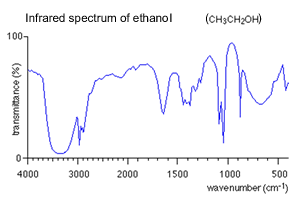Below is a table of some typical covalent bonds and their characteristic wavenumber at which energy is absorbed.
Bond
type |
Type
of molecule found in. |
Wavenumber |
C-O |
Alcohols
and esters |
1000-1300 |
C=O |
Carboxylic
acids and esters |
1680-1750 |
C=C |
Alkenes |
1600-1700 |
C-H |
Alkanes |
2850-3100 |
C-H |
Alkenes |
3000-3100 |
O-H |
Carboxylic
acids |
2500-3300 |
O-H
|
Alcohols |
3200-3600 |
Ethanol has the semi-structural
formula CH3CH2OH. Its IR spectrum
is shown on the right. We can see a number of troughs at wavenumbers:
- 3200-3500 representing the O-H bond;
- 2900-3000 representing the C-H bond;
- 1000-1100 representing the C-O bond.


- 1680 - 1750, representing the C=O bond;
- 2850 - 3100, representing the C-H bond;
- 1000`- 1300, representing the C-O bond.

C-H trough is seen at about
3000 .
C=O double bond is seen at about 1740 .
C-O single bond is seen at about 1240.
In the exam you may get a table
of data and asked to identify the possible functional groups that are
represented by each trough.

The O-H bond of an alcohol absorbs at a wavenumber around 3400 cm- while the OH bond of an acid absorbs somewhere between 3230 - 3550 cm-. Visually you can identify an acid or an alcohol by the shape of the trough representing the OH absorbance. You will notice that the absorbance of the acid OH overlaps the absorbance of the C-H bond at around 2950 cm-, where as the OH of an alcohol is further to the left at around 3400 cm- and is slightly more narrow.

What are some of the similarities you would expect to find when comparing the IR spectra of propanone and ethyl ethanoate? Solution
